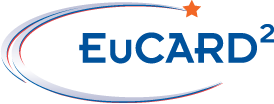The Editorial Series on Accelerator Science and Technology was started in 2008 as a joint initiative of the EU FP6 project CARE (link is external) and its successor, the EU FP7 project EuCARD. Copies from the Series up to Vol.18 volumes can be ordered here free of charge. From Vol 18 copies can be ordered here (link is external). If you need help with ordering, contact us
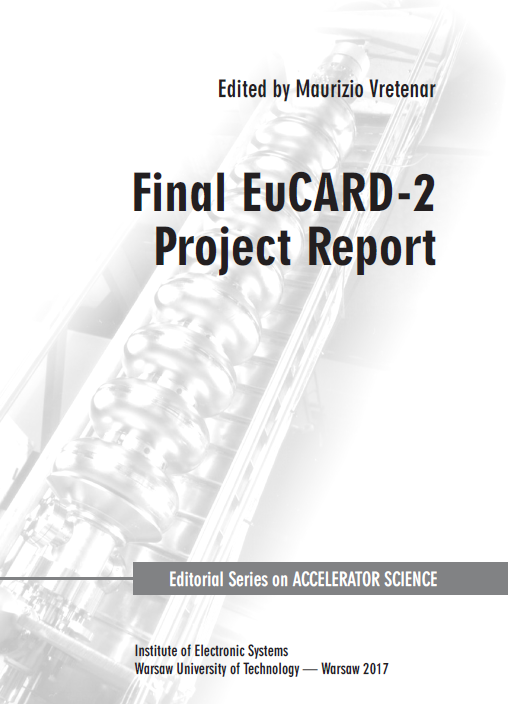 |
Vol. 45 - Final EuCARD-2 Project Report Maurizio Vretenar et al. This report presents the results and impact of EuCARD-2. |
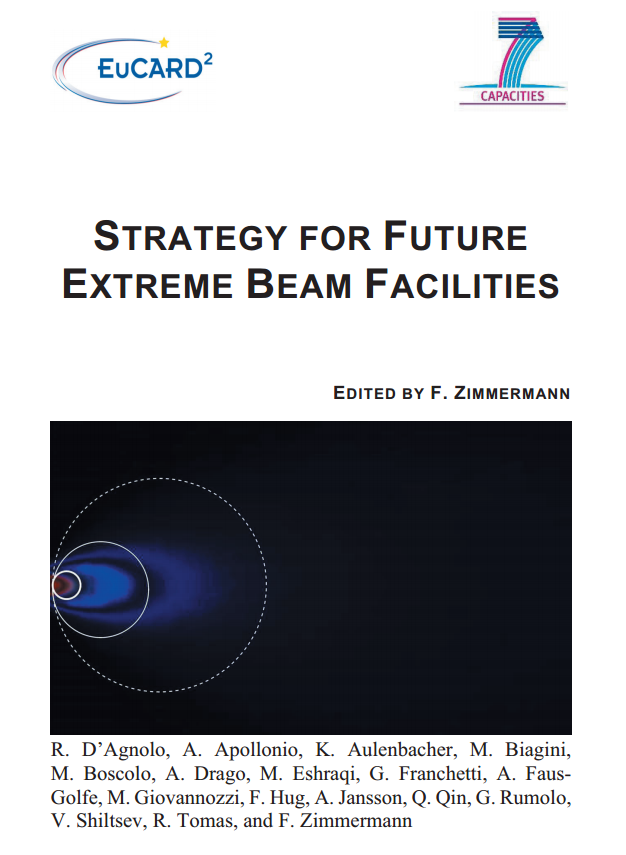 |
Vol. 44 - Strategy for Future Extreme Beam Facilities (EuCARD-2 Deliverable D5.5) Frank Zimmermann et al. (CERN) This EuCARD-2 XBEAM report summarizes the state of the art, discusses emerging new developments, and highlights a large number of upcoming and proposed projects, which will certainly push the existing boundaries. The report also underlines the important role played by the European accelerator networks, and it presents some tantalizing future perspectives, including large circular colliders, cold muon beams, crystals and nanotubes. |
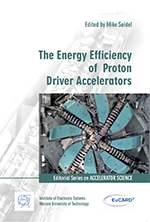 |
Vol. 43 - The Energy Efficiency of Proton Driver Accelerators Ch. Densham (STFC), F. Gerigk (CERN), J. Grillenberger (PSI), A. Lundmark (ESS), M. Seidel (PSI), M. Wohlmuther (PSI), V.Yakovlev (FNAL), 36 pages This report reviews the motivations and related applications of energy efficient accelerator technology. This details four sessions on energy efficiency topics such as beam targets, RF generation, accelerator concepts, and auxilliary systems. |
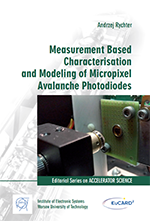 |
Vol. 42 - Measurement Based Characterisation and Modelling of Micropixel Avalanche Photodiodes Andrzej Rychter, 138 pages This dissertation contains a detailed research of new types of Silicon Photomultipliers which have been developed at the beginning of this century. The author was responsible for measuring new types of silicon photomultipliers (SiPM) which were planned to be used as photosensors in the new calorimeter—ECAL0 in COMPASS experiment in CERN. |
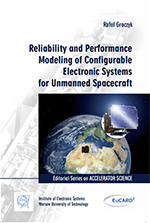 |
Vol. 41 - Dependable control and measurement systems modeling for unmanned spacecraft Rafał Graczyk, 158 pages In this thesis promising method of modeling complex systems using Petri networks is introduced in context of qualitative and quantitative dependability analysis. |
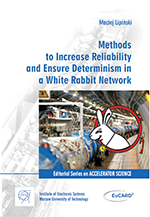 |
Vol. 40 - Methods to Increase Reliability and Ensure Determinism in a White Rabbit Network Maciej Lipinski, 233 pages The work for this thesis aims at providing standard-compatible specialised services that both ensure deterministic transmission of selected traffic through the WR network, and increase the reliability of the WR network |
 |
Antonella Chiuchiolo, 141 pages This thesis presents the progress done in the material selection and temperature characterization (in the range 300 - 4.2 K) of coated FBG sensors. Results of their implementation in the 20-m-long power transmission line for the helium gas temperature monitoring are also reported |
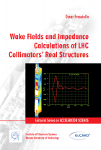 |
Vol. 38 - Wake Fields and Impedance Calculations of LHC Collimators’ Real Structures Oscar Frasciello, 122 pages The aim of this work was to perform accurate simulations of collimators’ impedance. The results of the collimators wake fields and impedances calculations, together with their comparison with experimental measurements are shown and discussed. |
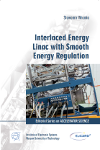 |
Vol. 37 - Interlaced Energy Linac with Smooth Energy Regulation Sławomir Wronka, 40 pages This report describes the construction and measurement of linear electron accelerator with a conversion target for the production of high energy X-ray radiation, as well as scintillator-based imaging detector |
 |
Lucas Nathan Brouwer, 233 pages This thesis aims to share new developments for Canted-Cosine Theta superconducting magnets, with the hope this design will improve technology for high energy physics and ion beam cancer therapy. |
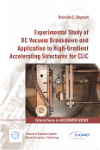 |
Nicholas C. Shipman, 196 pages This thesis presents investigations into the breakdown phenomenon primarily in the low breakdown rate regime of interest to CLIC, performed using the CERN DC spark systems between 2011 and 2014. |
 |
Tiina Salmi, 227 pages In this thesis work I analyzed in detail the present state-of-the-art protection heater technology, aiming to optimize its performance and evaluate the prospects in high-field magnet protection. |
 |
Thomas Flisgen, 196 pages This thesis presents the theory of the state-space concatenation approach and discusses several validation and application examples. |
 |
Vol.32 – Thermo-Mechnical Studies of Large Hadron Collider Collimators in Accident Scenarios Marija Cauchi, 272 pages The work presented in this thesis provides a more thorough understanding of the thermo-mechanical behaviour of TCTs during beam impact in accident scenarios. |
 |
Vol.31 – Crystal Collimation for LHC Daniele Mirarchi, 241 pages The main goal of this Ph.D. thesis is the design of an optimised prototype crystal collimation system for these tests in the LHC, which has been installed during April 2014. |
 |
Vol.30 – A Novel Data Acquisition System Based on Fast Optical Links and Universal Readout Boards Grzegorz Korcyl, 130 pages This thesis presents a concept, construction and tests of a modular and scalable,tree-structured architecture of a data acquisition system. |
 |
Vol.29 – Pinning Mechanisms in YBCO Tapes Marcello Spera, 159 pages In this thesis work, a study on flux pinning mechanisms of commer-cial YBCO tapes is presented. |
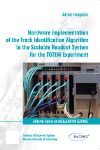 |
Bartłomiej Juszczyk, Grzegorz Kasprowicz, 98 pages The thesis is on the measurements in the TOTEM experiment. |
 |
Vol.27 –MicroTCA Based Platform for Advanced Particle Accelerators Diagnostics Adrian Fiergolski, 106 pages The thesis introduces a novel solution for measurement systems, a modern uTCA architecture. In this document an open source project of a base card (AFC -AMC to FMC carrier board) based on this standard has been described. In combination with a powerful FPGA device this card is an universal base circuit for variety of projects. Among the others it allows to implement algorithms which are collecting data from fast ADCs and to process these data. |
|
Vol.26 – Development of Radiation Hardened Pixel Sensors for Charged Particle Detection Michal Koziel, 238 pages CMOS Pixel Sensors are being developed since a few years to equip vertex detectors for future high-energy physics experiments with the crucial advantages of a low material budget and low production costs. The features simultaneously required are a short readout time, high granularity and high tolerance to radiation. This thesis mainly focuses on the radiation tolerance studies. |
|
|
Vol.25 – Designing the Four Rod Crab Cavity for the High-Luminosity LHC Upgrade Ben Hall, 213 pages This thesis presents the design for a novel compact crab cavity for the HL-LHC upgrade at CERN. The LHC requires 400MHz RF cavities that can provide up to 10MV transverse gradient across two to three cavities with suitably low surface fields for continual operation. As a result, a cavity design was required that would be optimised to these new parameters. From initial design studies based on Jefferson Laboratory’s CEBAF deflector, extensive optimization was carried out to design a superconducting crab cavity, dubbed the Four Rod Crab Cavity (4RCC). The thesis presents design considerations and studies. |
|
|
Vol 24 – Optics Designs of Final-Focus Systems for Future LHC Upgrades José Luis Abelleira Fernández , 168 pages The main topic of the thesis is the study of a novel option for the high-luminosity upgrade of the Large Hadron Collider (LHC) comprising a large Piwinski angle, flat beams, and crab waists. Flat beams and crab waists are not only pre-requisites for a crab-waist scheme, but, even by themselves; each of these two elements alone could boost the luminosity of the existing collider as built. |
|
|
Vol 23 – Electron Cloud Studies for the LHC and Future Proton Colliders César Octavio Domínguez Sánchez de la Blanca, 223 pages This thesis contributes to the understanding of the electron cloud observations during the first run of the LHC (2010-2012), presents the first beam dynamics analysis for the next generation of high energy hadron colliders, and assists in the prediction of how electron clouds will impact the performance of the future high-luminosity and high-energy machines. |
|
|
Vol 22 – EuCARD Final Project Report Jean-Pierre Koutchouk, Agnes Szeberenyi, 85 pages This report presents the results of the EuCard project. |
|
|
VOLUME 21 HAS BEEN WITHDRAWN |
|
 |
Maciej Kwiatkowski, 161 pages The aim of this thesis was to develop a method for reliable firmware implementation and to use that method to implement a new firmware for the Safe Machine Parameters (SMP) system. That system relies heavily on the Field Programmable Gate Arrays (FPGA) and it is one of the key machine protection systems of the Large Hadron Collider (LHC). |
 |
Vol.19 – Fast Automatic Beam Based Alignment of the LHC Collimator Jaws Gianluca Valentino, 237 pages A phased development, commissioning and usage of various algorithms in the 2011-2012 LHC runs allowed the alignment time to decrease to just over 4 hours, with no more beam dumps. The algorithms range from automatic selection of BLM thresholds during the alignment, to BLM-based feedback loops and pattern recognition of the BLM signal spikes. The BLM-based feedback loop was also successfully used by the ALFA and TOTEM particle physics experiments in Roman Pot alignment campaigns. |
